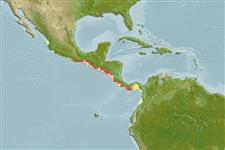Elasmobranchii (Haie und Rochen) (sharks and rays) >
Myliobatiformes (Stingrays) >
Urotrygonidae (American round stingrays)
Etymology: Urotrygon: Greek, oura = tail + Greek, trygon = a sting ray (Ref. 45335); cimar: Named for the Centro de Limnología (CIMAR) a research center of the Universidad de Costa Rica during its twentieth anniversary..
Environment: milieu / climate zone / depth range / distribution range
Ökologie
seewasser demersal; tiefenbereich 0 - 85 m (Ref. 40883), usually ? - 10 m. Tropical
Verbreitung
Länder | FAO Gebiete | Ecosystems | Vorkommen | Point map | Einführungen | Faunafri
Eastern Central Pacific: between Corinto, Nicaragua and Gulf of Nicoya, Costa Rica.
Size / Gewicht / Alter
Maturity: Lm ? range ? - ? cm
Max length : 38.2 cm TL Männchen/unbestimmt; (Ref. 40883)
Kurzbeschreibung
Morphologie | Morphometrie
Large species of Urotrygon with a round disc; tail short. Dorsal surface of disc and tail yellow-brown or tan irregularly spotted with brown or black blotches; ventral surface of disc white with lateral margins of disc and posterior border of pelvic fins tan in juveniles, dark brown or gray in adults. Small pungent denticles densely cover dorsal surface of disc and tail; denticles only slightly enlarged near midline. Pupillary operculum a small triangle, apex not reaching ventral margin of pupil.
Found in tide pools and to a depth of 85 m. Usually collected in waters shallower than 10 m.
Life cycle and mating behavior
Geschlechtsreife | Fortpflanzung | Ablaichen | Eier | Fecundity | Larven
López S., M.I. and W.A. Bussing, 1998. Urotrygon cimar, a new eastern Pacific stingray (Pisces: Urolophidae). Rev. Biol. Trop. 46 (Suppl. 6):271-277. (Ref. 40883)
IUCN Rote Liste Status (Ref. 130435)
Bedrohung für Menschen
Harmless
Nutzung durch Menschen
Mehr Information
LänderFAO GebieteEcosystemsVorkommenEinführungenStocksÖkologieNahrungNahrungsorganismenNahrungsaufnahmeNahrungsmenge
NamenSynonymeMetabolismusRäuberÖkotoxikologieFortpflanzungGeschlechtsreifeAblaichenSpawning aggregationFecundityEierEientwicklung
Alter/GrößeWachstumLänge-GewichtLänge-LängeLängenhäufigkeitenMorphometrieMorphologieLarvenLarven Pop.Dyn.RekrutierungDichteBRUVS
ReferenzenAquakulturAquakultur ProfilZuchtlinienGenetikElectrophoresesVererbbarkeitKrankheitenVerarbeitungNutrientsMass conversion
PartnerBilderStamps, Coins Misc.LauteCiguateraGeschwindigkeitSchwimmstilKiemenoberflächeOtolithsGehirngrößeSehfähigkeit
Tools
Zusatzinformationen
Download XML
Internet Quellen
Estimates based on models
Preferred temperature (Ref.
123201): 27.9 - 29.1, mean 28.5 °C (based on 98 cells).
Phylogenetic diversity index (Ref.
82804): PD
50 = 0.5001 [Uniqueness, from 0.5 = low to 2.0 = high].
Bayesian length-weight: a=0.01413 (0.00575 - 0.03468), b=3.07 (2.86 - 3.28), in cm total length, based on LWR estimates for this (Sub)family-body shape (Ref.
93245).
Trophic level (Ref.
69278): 3.7 ±0.6 se; based on size and trophs of closest relatives
Widerstandsfähigkeit (Ref.
120179): niedrig, Verdopplung der Population dauert 4,5 - 14 Jahre. (Assuming fecundity<100).
Fishing Vulnerability (Ref.
59153): Low to moderate vulnerability (28 of 100).
